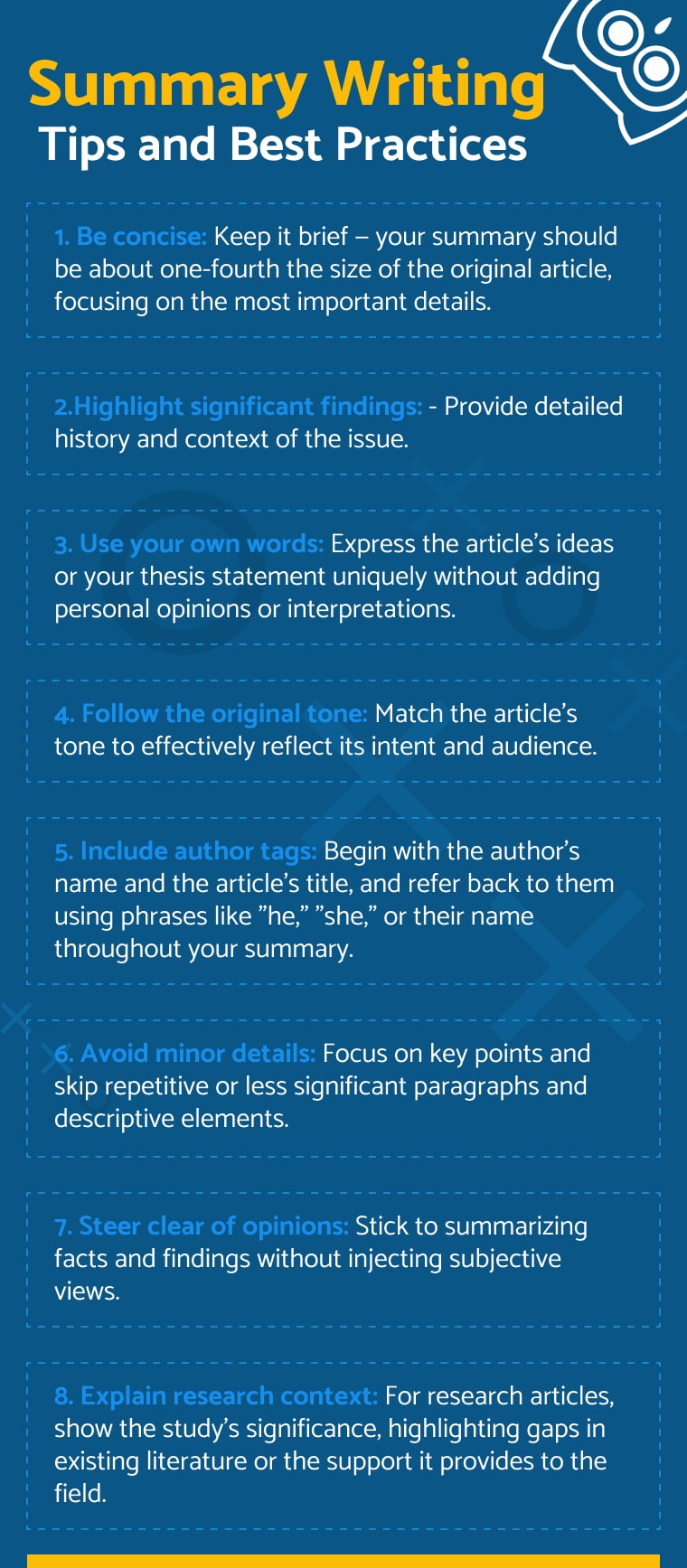How to Write a Summary of an Article: Brevity in Brilliance
Table of contents
Summarizing an article may seem straightforward. Still, crafting a clear, concise summary that captures the article’s main ideas can be challenging. This guide provides practical steps and insights to help you effectively summarize an article while retaining the most important points and avoiding common pitfalls.
Before diving in, here’s what this article will cover:
- The essence of a summary and how to approach it.
- Key points for writing a successful research summary.
- Tips for identifying an original article’s thesis statement and any supporting detail.
- Examples to illustrate effective article summaries.
- Mistakes to avoid, such as overusing direct quotations or straying from the author’s ideas.
This guide is for those who want to learn to highlight the most important details of an article, organize them into a cohesive paragraph, and express the content in your own words to avoid plagiarism.
Whether you’re summarizing for academic or professional purposes, these strategies will ensure your summary begins with clarity and ends with precision.
What Is an Article Summary?
An article summary is a shortened version of a longer piece, such as an article, research paper, or report. It highlights the main idea, important facts, and author’s ideas, offering readers a quick overview without requiring them to read the entire original text.
Written in your own words, an effective summary distills the essential main points while avoiding quotes unless absolutely necessary. This process sharpens your ability to identify supporting details and strengthens your writing skills.
Mastering the art of writing a summary is invaluable for students. It can improve critical thinking skills and make it easier to analyze texts. You create a critique that provides clarity and insight by taking notes, explaining key sentences, and organizing ideas into a cohesive paragraph.
Maybe you should simply do your college essays and summarize them for academic purposes or professional needs ━ it doesn’t matter! If the stakes are high, many students decide to pay for college essay writing to ensure a perfect, stress-free submission. The goal is to create a clear overview that captures the main points and supports the reader’s understanding.
Difference Between Abstract and Research Summary Writing
Abstracts and summaries may seem similar, but they serve distinct purposes. An abstract comes first in an academic article and briefly outlines the main idea, background, and thesis, which is often required before publication.
In contrast, a research summary appears last, emphasizing methodology, findings, and the key points of the original text.
Both of them provide condensed overviews. Still, the abstract highlights the most important details and hypotheses, while the summary includes supporting details like methods and results.
When writing a summary, avoid direct quotations, focus on identifying the main points, and craft an engaging paragraph that captures the article’s essence.
Steps to Write a Summary for an Article
Summarizing is a powerful skill for clear communication. Whether simplifying academic articles, complex reports, or everyday reads, mastering this art helps you grasp and share essential ideas effectively. Here’s how you can craft compelling summaries:
Prepare to Summarize
- Read the original article thoroughly — start with a quick read to grasp the thesis statement and overall message.
- On your second read, note key details and arguments while analyzing the audience and the author’s intent.
Identify Main Ideas
- Focus on the main points in each section.
- Find answers to the “Five Ws”: Who, What, When, Where, and Why.
- Highlight topic sentences and examples that define the article’s core message.
Write the Summary
- Organize your notes into a clear structure with an introduction, body, and conclusion.
- Start with the thesis statement, expand on key arguments, and wrap up with a last sentence summarizing the piece.
- Keep your paragraphs brief, explaining and supporting the most crucial details without unnecessary repetition.
These main steps of article review writing help you craft concise, engaging, and informative summaries. Up next, we’ll dive into summary-specific formatting tips to refine your approach!
Outline Your Research Summary
Creating a well-organized research summary involves more than just knowing how to cite sources or filter information. You need to present your findings in a clear academic structure. Below are the essential components for crafting a research paper summary:
Introduction
Start with a brief overview of the original article or research. Present the topic sentence that outlines the article’s main ideas and gives your audience context. Highlight the relevant background to make the subject approachable.
Methods Section
In the methods section, explain the tools and approaches used in the study, such as tests, surveys, databases, or statistical analysis.
Focus on summarizing the process without delving into excessive detail. For instance, mention the methodology briefly to keep it concise and carefully aligned with your summary’s goal.
Results
Present the key findings of your research clearly. This section should summarize the data gathered and any supporting theories.
Highlight only the most relevant details and avoid unnecessary repetition, ensuring your reader can quickly grasp the outcomes.
Discussion
Analyze and evaluate the results in the context of existing trends or theories. Discuss the study’s advantages and limitations while connecting findings to the broader research landscape. Suggest areas for future exploration to expand the study’s relevance if needed.
Conclusion
Wrap up with a concise summary that supports or challenges the initial theories based on the evidence. Include this in a separate paragraph to emphasize your argument and bring closure to the summary.
With this structure, you’ll create a clear, impactful research summary conveying essential ideas while respecting academic standards.
Example of Perfect Outline
While our guide and tips can be used for various types of written pieces, there are also various types of articles. Options can vary from professional essay writing to informative article synopsis. If your academic load involves multiple complex documents, hiring a service to do my papers can be an excellent strategy for managing deadlines.
Still, here is an example of a good outline that you can apply to different types of articles:
- Introduction
- Background.
- A brief overview of the rise of social media.
- It is important to study its impact on mental health.
- Research question.
- Statement of the problem.
- Purpose of the study.
- Literature Review
- Overview of social media usage among adolescents.
- Statistics on social media penetration.
- Common platforms and their features.
- Previous research on the relationship between social media and mental health.
- Studies supporting a negative and/or a positive impact.
- Gaps and inconsistencies in existing literature.
- Methodology
- Research design.
- Quantitative approach.
- Cross-sectional survey.
- Data collection.
- Survey instrument details.
- Ethical considerations.
- Data Analysis
- Statistical methods.
- Descriptive statistics.
- Inferential statistics (e.g., regression analysis).
- Presentation of results.
- Tables and figures.
- Key findings.
- Discussion
- Interpretation of results.
- Correlation between social media usage and mental health.
- Identification of patterns and trends.
- Implications.
- Practical implications for parents, educators, and policymakers.
- Suggestions for future research.
- Conclusion
- Summary of key findings.
- Final remarks on the study’s contribution to the field.
Structure Types
So, now you can see the best practices and structure types for writing empirical and argumentative summaries. The only thing left to discuss is to go through our above example and divide its structure into distinctive parts, which you could use when writing your summary.
- The best way to start is by mentioning the article’s title and author. It’s best to keep it straightforward: “In “Who Will Be In Cyberspace,” author Langdon Winner takes a philosophical approach…”
- The next part is critical for a good summary since you’ll want to captivate the reader with a short one-point thesis. If you look at our example, you’ll see that the first sentence or two contains the main point, the title, and the author’s name.
- So, that’s an easy way to get straight to the point while also sounding professional, and this works for all the essay structure types. You should also briefly highlight the main supportive points: “He supports this through the claims that people working in the information industry should be more careful about newly developed technologies…”
- The key is to keep it neutral and not overcomplicate with supportive claims. Try to make them as precise as possible and provide examples that directly support the main thesis.
- You can conclude the summary by once again mentioning the article’s main thought; this time, you can make the connection between the main thesis and supporting points to wrap up.
Common Mistakes to Avoid
To craft an article summary, steer clear of these common errors to ensure your work is genuine and professional. An effective and accurate article summary that reflects the original article authentically is guaranteed to avoid these mistakes:
- Avoid plagiarism in your text: Always use your own words to summarize the original article and focus on the author’s argument rather than copying phrases or ideas directly.
- Misrepresenting the author’s main ideas: Stay aligned with the article’s main ideas. Drifting away from them leads to inaccuracies and weakens the summary’s quality.
- Overusing quotes: Do not include direct quotes from the author or other article summaries. Rely on your ability to identify and restate the additional information instead.
- Sharing personal opinions: Unless it’s a scientific article summary where you are requested to provide your take as a researcher, avoid inserting your viewpoint. Do it only if the task requires a critique or analysis, such as for a novel or short story.
- Being overly brief or vague: Ensure the summary provides enough information to explain the author’s key points while staying focused.
Summary Writing Tips and Best Practices
When writing a summary, consider these key points to stay on topic and create an effective essay outline:

These steps guide you to craft a clear, precise summary with a solid essay outline that perfectly reflects the essence of the original.







